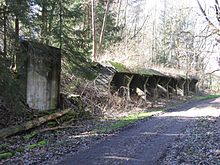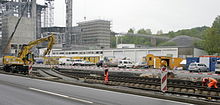Kerkerbachbahn
| Kerkerbachbahn | |||||||||||||||||||||||||||||||||||||||||||||||||||||||||||||||||||||||||||||||||||||||||||||||||||||||||||||||||||||
|---|---|---|---|---|---|---|---|---|---|---|---|---|---|---|---|---|---|---|---|---|---|---|---|---|---|---|---|---|---|---|---|---|---|---|---|---|---|---|---|---|---|---|---|---|---|---|---|---|---|---|---|---|---|---|---|---|---|---|---|---|---|---|---|---|---|---|---|---|---|---|---|---|---|---|---|---|---|---|---|---|---|---|---|---|---|---|---|---|---|---|---|---|---|---|---|---|---|---|---|---|---|---|---|---|---|---|---|---|---|---|---|---|---|---|---|---|---|
| Course book section (DB) : | ex 195h, 194u | ||||||||||||||||||||||||||||||||||||||||||||||||||||||||||||||||||||||||||||||||||||||||||||||||||||||||||||||||||||
| Route length: | 35.1 km | ||||||||||||||||||||||||||||||||||||||||||||||||||||||||||||||||||||||||||||||||||||||||||||||||||||||||||||||||||||
| Gauge : | 1000 mm ( meter gauge ) | ||||||||||||||||||||||||||||||||||||||||||||||||||||||||||||||||||||||||||||||||||||||||||||||||||||||||||||||||||||
| Maximum slope : | 20 ‰ | ||||||||||||||||||||||||||||||||||||||||||||||||||||||||||||||||||||||||||||||||||||||||||||||||||||||||||||||||||||
| Minimum radius : | 80 m | ||||||||||||||||||||||||||||||||||||||||||||||||||||||||||||||||||||||||||||||||||||||||||||||||||||||||||||||||||||
| Top speed: | 25 km / h | ||||||||||||||||||||||||||||||||||||||||||||||||||||||||||||||||||||||||||||||||||||||||||||||||||||||||||||||||||||
|
|||||||||||||||||||||||||||||||||||||||||||||||||||||||||||||||||||||||||||||||||||||||||||||||||||||||||||||||||||||
The Kerkerbachbahn Aktien-Gesellschaft existed from 1884 to 1984, from 1886 to 1975 as an active railway company . The company was the operator and owner of the Kerkerbachbahn located in the southern Westerwald , a railway line that ran from Dehrn via Kerkerbach (an industrial area of the town of Runkel and waters of the same name) in the Lahn valley north to Mengerskirchen through what is now the Limburg-Weilburg district in Hesse .
history
founding of the company
The Kerkerbachbahn Aktien-Gesellschaft was founded on May 12, 1884 by ten private individuals in Limburg an der Lahn ; the majority of the shareholders were Dutch citizens. The company moved its headquarters to Christianshütte in 1887 and to Kerkerbach in the Oberlahn district in 1906 . The company's purpose was the "construction and operation of a narrow-gauge branch line for the transport of people and goods between Heckholzhausen and Dehrn with a connection to the Prussian State Railroad in Kerkerbach" .
Construction of the railway line

This typical small railway from Kerkerbach to Heckholzhausen was legally a fully-fledged railway because the Prussian Small Railway Act - which provided for less strict requirements for construction and operational management - did not yet exist when it was founded. The railway was supposed to transport ore , limestone , marble , basalt and clay , the natural resources of the southern Westerwald, to the port of Steeden on the Lahn and to the state train station Kerkerbach on the Lahn valley line from Giessen to Limburg . For the travelers, however, this connection meant that they had to change trains in the direction of Limburg or Weilburg , even to the nearby official town of Runkel.
The first four-kilometer section was laid out with three rails - in normal and meter gauge - from Kerkerbach down the Lahn via Steeden to Dehrn, where from May 1, 1886 initially only freight trains ran. Passenger trains followed two years later, on June 1, 1888, when passenger traffic up the valley via Schupbach to Heckholzhausen was also started in the Kerkerbachtal . Goods traffic had already started here on November 5, 1887 to Eschenau and on January 10, 1888 via Christianshütte, which was the center of operations at that time, to Heckholzhausen.
It was only after a break of more than a decade that it was decided to continue this narrow-gauge "upper route" up into the Westerwald. Hintermeilingen was reached on October 1, 1905, Waldernbach on October 24, 1907 and finally Mengerskirchen on April 15, 1908. The entire Kerkerbach Railway had thus reached a length of 35 kilometers.
Development of the railway
The extension of the route from Heckholzhausen to Mengerskirchen turned out to be a financial failure. This was due on the one hand to the steep and winding route with a journey time of around two hours, and on the other hand to the economic crisis at the end of the First World War, which also included an extension planned before the outbreak of the war and thus an economic reorientation to the north (Hoher Westerwald) from Mengerskirchen shelved. On November 15, 1920, public operations to Winkels and Mengerskirchen ceased. The AG Eiserfelder Steinwerke bought the line from Hintermeilingen in 1920 and operated it as a private siding under the name Hintermeilingen-Mengerskirchener Anschlussbahn GmbH until 1935.
For years, several connecting railways for freight traffic were also operated as junctions from the regular route. a. in the period from 1937 to 1939 for the construction of the A 3 motorway bridge over the Lahn near Dietkirchen .
End of passenger traffic
The always modest passenger traffic (two to three pairs of trains per day) ended on the section between Kerkerbach and Dehrn as early as 1929, but between Kerkerbach and Hintermeilingen, mainly due to the lack of other transport options during the Second World War and the period immediately following, it could continue until June 1st Hold 1958. Then only one pair of trains was offered from Kerkerbach to Schupbach, which was also canceled exactly two years later. The Kerkerbachbahn had also had a small bus operation since 1949 , which at times included city lines in Limburg; However, substantial parts of their catchment area were developed by Kraftpost and other companies with direct lines to Limburg and Weilburg.
End of freight traffic
In 1958, the Kerkerbachbahn acquired one narrow-gauge and one standard-gauge diesel locomotive from Ruhrtaler . But on December 17, 1960, the rest of the freight traffic on the line in the Kerkerbachtal was abandoned and all narrow-gauge tracks were dismantled. In contrast, the removal of limestone from a quarry at BASF Ludwigshafen in Steeden resulted in continued good utilization of the lower section between Dehrn, Steeden and Kerkerbach. The Kerkerbachbahn AG initially continued to operate this section until the Deutsche Bundesbahn took it over as a siding under its own management on January 1, 1975 . The Kerkerbachbahn-Gesellschaft gave up all transport operations and entered the real estate business with new shareholders until it had to file for bankruptcy in 1984 - one hundred years after it was founded .
Current condition
The tracks on the stretch between Kerkerbach and Mengerskirchen were dismantled after the individual sections were closed. Today there is a footpath and bike path on parts of the route . The section from Kerkerbach via Steeden to Dehrn still exists as the DB Netz AG infrastructure , but was not used from 2000 to 2009. In Dehrn, many of the tracks in the southern area have already been removed. The track systems in the area of the lime works are still there, including many switches.
At the end of March 2007, Schaefer Kalk GmbH & Co KG, owner of the Steedener lime works, decided to expand the facilities in Steeden. In this context, the still existing route from Kerkerbach was reactivated until shortly before Dehrn. The track construction work began in September 2008, and on November 3, 2009 the line was used for the first time by a train.
literature
- Andreas Christopher: The Kerkerbach Railway . 2nd edition, Schweers + Wall, Aachen 2001, ISBN 3-89494-121-9
- Gerd Wolff, Andreas Christopher: German small and private railways, Volume 8: Hessen . EK Verlag, Freiburg 2004, ISBN 3-88255-667-6





